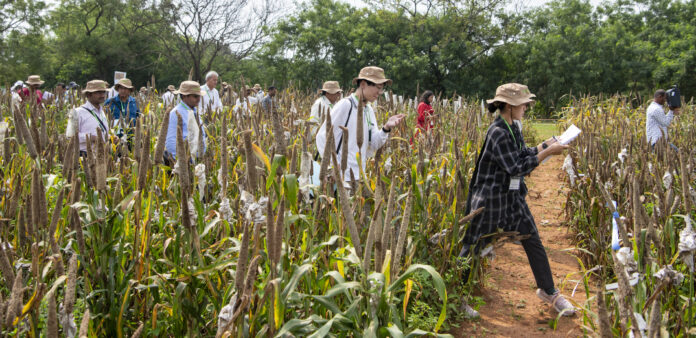Over 90 scientists from public and private sectors have explored 15,000 pearl millet unique breeding lines planted in display fields during a biennial Pearl Millet Scientists’ Field Day from 3-4 October 2024 hosted by the International Crops Research Institute for the Semi-Arid Tropics (ICRISAT).
Participants from India, Japan, Brazil, and the U.S. selected breeding material for research focused on cultivars with combination traits, such as higher yields and resistance to biotic and abiotic stresses. Innovations like biofortified forage and multi-cut summer pearl millet were prominent in the discussions and selections.
In his inaugural address, ICRISAT’s Deputy Director General-Research, Dr Stanford Blade, welcomed the participants and highlighted the growing recognition of millet as a “smart food,” building on the visibility it gained during the International Year of Millets (IYoM) 2023.
“This is a unique group. It’s great to see the public and private sectors together here. Though we come from various organizations with different interests, we are united in our goal of developing new cultivars that will positively impact lives and livelihoods,” Dr Blade said, emphasizing the power of collaboration.
The two-day event was chaired by Dr Sean Mayes, ICRISAT’s Global Research Program Director, Accelerated Crop Improvement; and co-chaired by Dr T Napolean, Principal Scientist at the Indian Institute of Millets Research (IIMR), representing IIMR Director Dr Tara Satyavathi.
“Pearl millet is a key crop for the future. With significant genetic gains driven by your efforts, it plays a crucial role in food and nutrition security. ICRISAT’s Hybrid Parents Research Consortium has been making a meaningful impact for 20 years, benefiting seed industry partners both locally and internationally,” said Dr Mayes.
“IYoM 2023 significantly raised public awareness about pearl millet, and that momentum continues. In the face of climate change, pearl millet is being recognized as a strategic crop for the future,” said Dr Napolean.
Dr OP Yadav, Director of the Central Arid Zone Research Institute, Dr Vijay Kumar Yadav, Principal Coordinator of the All India Coordinated Research Project (AICRP) on Forage, and Dr Narendra Kumar Patil, Chair of the Advisory Committee of HPRC, highlighted key priorities for pearl millet development. They emphasized the importance of breeding cultivars capable of yielding 4 to 5 tons of grain per ha under irrigated summer season, unlocking its potential as a forage crop, and developing agroecology-specific varieties to address diverse environmental needs.
ICRISAT scientists played a key role in guiding the participants through various activities. Dr SK Gupta, Principal Scientist-Pearl Millet Breeding, led the tour of 15,000 breeding plots, showcasing materials with desirable traits for adaptation. During the feedback session, he highlighted the efforts of ICRISAT towards the development of breeding materials for drought ecology through shuttle breeding, and also informed about the different strategies practiced to breed for blast resistance.
Dr Rajan Sharma, Principal Scientist-Crop Protection & Seed Health, and his team demonstrated screening protocols for disease-tolerant donor parents at the Downy Mildew and Blast Nurseries, and the Genebank team provided an overview of the genetic resources available for pearl millet research.








